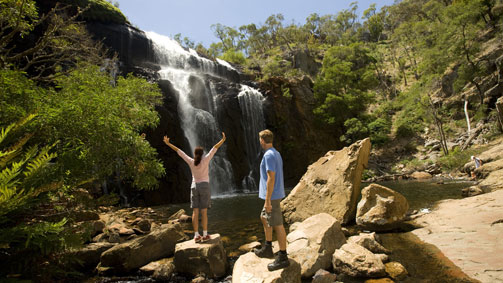See rugged mountains, vast plains, ancient Aboriginal rock art sites, unique native plants and animals, majestic waterfalls and vibrant wildflowers.
A world within a national park
Immerse yourself in the mountains and forest of the Grampians National Park, springing up from the surrounding plains. Explore the eco systems and learn about the diverse array of native plants and animals, some of which are unique to the area. See evidence of Aboriginal people’s long association with the Grampians at rock art sites throughout the park.
Survey your surrounds from any number of scenic lookouts around the park and admire the rock formations and varied landscape.
Ascend the summit of Mt Arapiles for vast views of the region, or marvel at the delicate balance of natural forces in Little Desert National Park, a desert in name only.
Wildflowers and roaring waters
Witness the power of water as deafening torrents cascade down rock faces and gorges into lush pools below.
Come to the region in spring to see the “garden of Victoria” covered in a carpet of colourful wildflowers.
Well-groomed gardens
Swap the rugged mountains for pristine historic gardens in regional towns, some of which were designed by revered landscape gardeners and are examples of Australia’s earliest provincial botanic gardens. Peek into private gardens at open weekends throughout the year.
See kangaroos, wallabies, emus, echidnas and a myriad of bird species at home in their natural habitats in the Grampians region.
Keep your eye out for over 200 species of birds, 35 species of mammals, 28 species of reptiles, 11 species of frogs and six kinds of native fish in the region’s varied environment.
Encounter kangaroos and wallabies
Marvel at the sheer number of kangaroos and wallabies, whether wandering the main streets of Halls Gap and Pomonal, or in paddocks and bush land surrounding towns and villages, unconcerned by passers by.
Keep the camera at the ready for the sight of male emus shepherding youngsters on a foraging expedition, or echidnas seeking out an insect feast.
Catch a glimpse of endangered species
Admire wedge-tailed eagles as they soar high, and see parrots, lorikeets and honeyeaters feeding on forest plants.
In the desert country, try and catch a glimpse of the shy desert mallee fowl or endangered red tailed black cockatoo. In the heathlands expect wrens, robins, whistlers and fantails as they flit from ground to bush.
At dawn and dusk, listen for the laugh of the kookaburra, or after dark for the calls of the powerful owl, boobook owl and even the shy tawny frogmouth. The evening is also a fantastic time for viewing possums and sugar gliders.









